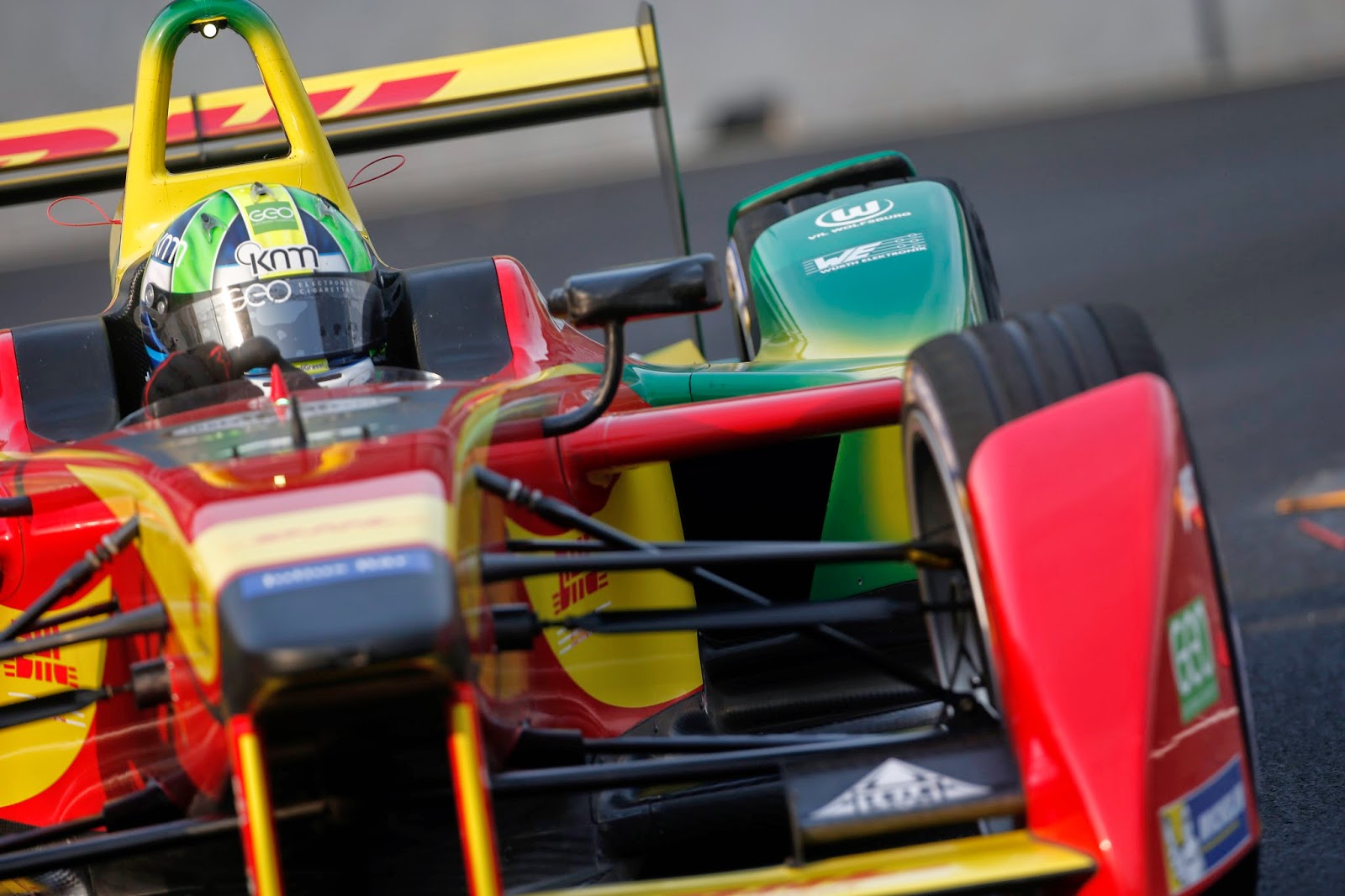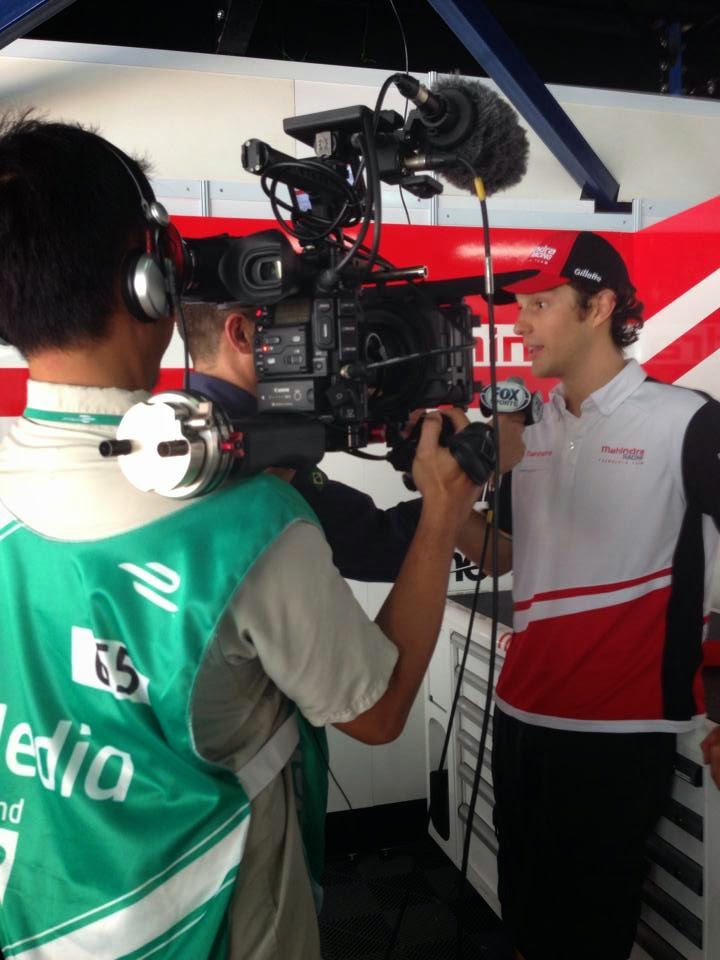 |
| the GM Ultralite used in Demolition Man |
Remember the funky black and white San Angeles police squad cars in the movie? The 1993 movie used GM's Ultralite concept car which back then (21 years ago mind you!) had the foresight (or is it hindsight?) to be battery electric powered.
Anyhow, fast forward two decades and the idea of battery powered and/or hybrid cars have become a reality. Sure, it's not 2032, and Taco Bell hasn't ruled the franchise world. While it's true that electric-powered automotive technology has not quite evolved to that almost utopian hope of reducing our collective carbon footprint (or treadwear), the industry has made significant strides, at least in that general direction. Today (being 2014), there are over a dozen auto manufacturers offering nearly 20 different models of electric-powered vehicles with varying permutations.
 |
| The BMW I8 used in the Formula E Championship |
Of course, the combustible engine hydro-carbon powered cars remain the predominant consumer preference and choice on our Malaysian roads, but the case for electric-powered cars is a compelling one for some. However, with the infrastructure still in its infancy (some claim still at the conception stage even), the attractiveness of an electric option is somewhat diminished despite government tax breaks, therefore ensuring the continued supremacy of the gas-guzzling monsters on the pot-holed roads that dot the asphalt landscape of this nation. .. Well, for now, at least..
But, how often have you found your attention straying to that odd looking Nissan Leaf or Mitsubishi i-MiEV or even that darn Smart car on the road, more than that annoying headlight flashing ass-kissing Panamera in your rearview mirror? Me, I know I might gawk at the BMW I3 (or whimper at the BMW I8) or the Tesla S if I saw one... I remember crying inside when I was first introduced to the Mercedes Benz SLS AMG Electric Drive by former colleagues in Affalterbach... OK, maybe I am an anomaly.
What? Electric racing?
While the idea of electric-powered vehicles is very slowly making its way from to the outer layers of the consumer psyche, e-vehicles as a choice for mobility is still something a vast majority of us would go, "huh?" at. Now imagine that concept in racing. "What?!"
Energy efficiency and sustainability are not often words or concepts one might automatically associate with automobile racing. Especially when one has spent ones youth salivating at the 20 or so brave souls engaged in a vehicular gladiatorial contest of who's fastest in their carbon-fibre armoured fuel-burning machines, hurtling down the racetracks at top speeds in excess of 300km/h almost every other fortnight.
 But, in recent years, the idea of energy efficiency has already begun creeping into racing in various forms and at various stages. For instance, clever engineering to recover wasted energy under braking and transforming that energy into additional electrical power for formula one cars. I won't even attempt to explain that as physics was my achilles heel in school.
But, in recent years, the idea of energy efficiency has already begun creeping into racing in various forms and at various stages. For instance, clever engineering to recover wasted energy under braking and transforming that energy into additional electrical power for formula one cars. I won't even attempt to explain that as physics was my achilles heel in school. Regulation changes centred around energy efficiency had begun to appear across other championships as well, including even the infamous LeMans 24Hours, when hybrid vehicles with KERS or TERS (Kinetic/Thermal Energy Recovery Systems) began appearing in 2009.
Suffice to say, the mood and attitudes in the upper echelons of racing is certainly shifting, perhaps in response to changing demands. There's no denying that technological innovation remains the mainstay in the motoring and auto racing industry, but the direction in which that innovation has taken is what is fascinating. This in spite of the very public debates on savings or innovation.
Essentially though, change was in the offing, innovation wise, anyway. Either side of the force, it was probably a matter of time before the players in the industry would embrace the idea of a flagship championship built on technologically advanced innovation around electric-power as opposed to fossil-fuel powered combustion engine race cars.
Drive the future
Drum roll please.... here it is.. Introducing the FIA Formula E Championship.
I first heard of it late in 2013 (OK, so I don't put my ears to the ground as often as I would like, sorry). Then I bumped into an ex-Formula 1 test driver who was about embark on his first ever Formula E (FE) test. I was curious. As I spoke to him he went on to explain how excited he was and what it was all about.
 |
| The inaugural FIA Formula E Championship commenced in September with the Beijing ePrix. |
Naturally, that piqued my interest. As I attempted to devour as much information as I could gather, my curiousity began to grow. I came to learn that the championship is built on the premise of being a framework for research and development around electric mobility and ultimately the future of the auto industry; an effort that makes that link between motor racing and motoring industry and the future more defined.
Sauntering (actually, I was running about like a headless chicken, but anyway) about the paddock at the recently concluded Putrajaya ePrix, I simply could not resist the urge to corner Michael Andretti.. Yes, that Andretti, CEO of Andretti Autosport and get his point of view. "This [Formula E] could very well be the future of auto racing, and that is what got us really excited."
I wondered if it was a huge leap from what they had done in the past, to which Andretti answered, "I wouldn't say it's a huge change, as there is still the basics of racing, but you have to change your thinking on how you approach it, the way you approach strategy and how you manage your energy, for instance. Formula E is a new challenge and one that we really like."
 |
| Audi Sport ABT Formula E's Lucas di Grassi |
Speaking to both Bruno Senna (Mahindra Formula E) and Lucas Di Grassi (Audi Sport ABT Formula E) whilst waiting for a certain high-ranked dignitary at a gala-ladi-da event, both echoed similar sentiments. "You really have to change your attitude toward this type of racing because it is different from any other kind of racing in other categories. You have to change how you approach racing in these cars."
Theirs was a sentiment that even Jaime Alguersuari (Virgin Formula E) and Nico Prost (e-DAMS Formula E) both shared with me. One said, "you have to change your driving style and change the way you think about it and there is a higher degree of responsibility on the part of the driver, particularly in managing how you race against the energy available to you."
Mahindra's Karun Chandhok put it to me this way, "It is very different [driving this car], as we have no engines and we run on battery power. There are a lot of things that are very different compared to a normal racing car, for instance, in terms of weight and weight distribution and the tyres as we don't use slicks. Then there is the fact that we only race on street circuits, which I really like a lot!"
Breaking Perceptions
 |
| Alejandro Agag, CEO of the FIA Formula E |
Alejandro puts it simply, "this is not just another series, it is a series all on its own." He said in an interview, "we are looking to the future, looking to find ways to change the world, particularly in the area of mobility."
This especially in the area of electric mobility and in breaking the perception that electric cars are for boring and slow geeks, to which Alejandro adds, "by showing skeptics these electric cars racing, we can change the perception around electric mobility."
Best part is that the engineering minds behind the scenes working with this huge moving research and development laboratory, are hard at work making the batteries last longer and these cars faster. That trajectory is onwards and upwards, for sure, especially as I couldn't help but notice the presence of and growing curiosity of some of the biggest names in the auto industry. Perhaps.... hmm..
One thing that I found particularly interesting is the fact that the series only races on street circuits (which the drivers love), a point that Alejandro explains is especially crucial. Because Formula E is ultimately about contributing toward research and development; and the future of electric mobility, the fact that the races happen on street circuits of major capital cities around the world is a strategic one because as Alejandro points out, "Formula E has a unique opportunity to help combat carbon emissions. And the fight against carbon emissions happens first in the cities. The world is going towards a concentration of the population in the big cities. 80% of the pollution is going to come from the cities by 2020. So to fight carbon emissions we need to find solutions in the cities and the big part of it is mobility, how we move around. If we can move around the cities in a clean way, we are already one step closer to our goal."
Reaching Out
 |
| I've done my fair share of photoshoots, this has to be the most chilled out.. |
What's interesting is that channel of communication extends beyond the team garages, race control and pitlane into cyberspace, especially to young netizens out there prowling the world wide web. The primary characteristic of Formula E is the element of youth in the championship's demographic target group.
 |
The students at the Heriot-Watt University Malaysia campus gets an
exclusive session with the drivers and Spark, the men who built the
Formula E cars.
|
Why the youth? "The new generation, or the millennials, have a much shorter attention span and have a very different way of interacting with the world, preferring entertainment or sporting events that they are able to interact with through their mobile devices," notes Alejandro.
Ultimately there is also another point to this, by attracting the younger audience who are also very conscious of the world they live in, Alejandro explains, "by the time these kids are 18 years old and they decide to buy a car, that car will most probably be an electric one. So in that way, Formula E is a championship targeted to younger fans."
In reverberating the same sentiments, Michael Andretti notes, "the Millennials are really important because auto racing in general has a real challenge because our demographics are getting older and older."
If Formula E can attract a younger audience, they're more likely to remain interested in it, particularly if they can interact with it in a real way. Bruno Senna's use of his fanboost at the Putrajaya ePrix would have definitely proven this to his fans that it works and it did have an impact on his race.
 |
Bruno Senna used his
fanboost at the Putrajaya ePrix
|
Granted, the inaugural series is only two races old, and is very far from over. But, judging from all the conversations I had up and down the pitlane, in the paddock, in the studios, in the media centre and with championship partners, there is an energy around and about the Formula E that is infectious, one that one could almost call electric. I know that's cheesy, I'm sorry but that is the vibe I get.
I'm excited about the series and can't wait to see what's in store for the FIA Formula E Championship. I can only see it get better and better as the kinks get ironed out, so, yeah, bring it on!
And in case you missed the race, here's highlights of that electric weekend.


















.JPG)
